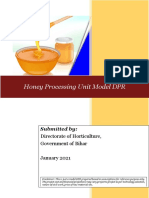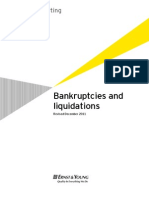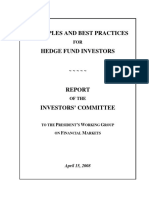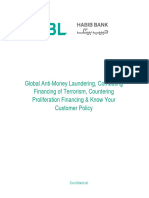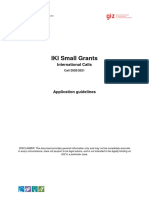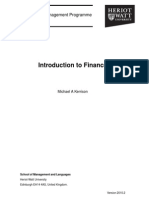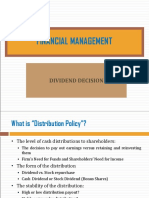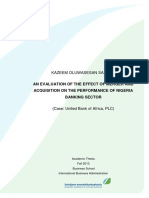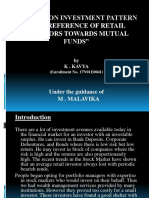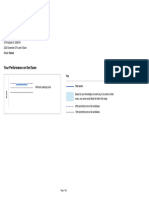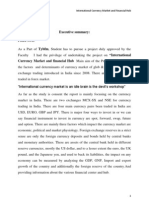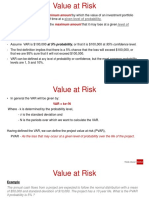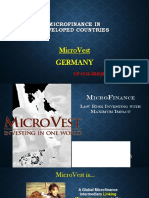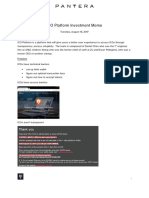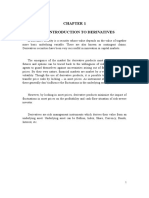R47 Introduction To Alternative Investments
R47 Introduction To Alternative Investments
Uploaded by
Sumair ChughtaiCopyright:
Available Formats
R47 Introduction To Alternative Investments
R47 Introduction To Alternative Investments
Uploaded by
Sumair ChughtaiOriginal Title
Copyright
Available Formats
Share this document
Did you find this document useful?
Is this content inappropriate?
Copyright:
Available Formats
R47 Introduction To Alternative Investments
R47 Introduction To Alternative Investments
Uploaded by
Sumair ChughtaiCopyright:
Available Formats
R47 Introduction to Alternative Investments 2022 Level I Notes
R47 Introduction to Alternative Investments
1. Introduction ......................................................................................................................................................3
1.1 Why Investors Consider Alternative Investments ......................................................................3
1.2 Categories of Alternative Investments.............................................................................................4
2. Investment Methods ......................................................................................................................................5
2.1 Methods of Investing in Alternative Investments .......................................................................5
2.2 Advantages and Disadvantages of Direct Investing, Co-Investing, Fund Investing........5
2.3 Due Diligence for Fund Investing, Direct Investing, and Co-Investing ................................6
3. Investment and Compensation Structures ............................................................................................7
3.1 Partnership Structures ...........................................................................................................................7
3.2 Compensation Structures......................................................................................................................8
3.3 Common Investment Clauses, Provisions, and Contingencies ...............................................8
4. Hedge Funds ......................................................................................................................................................9
4.1 Characteristics of Hedge Funds ..........................................................................................................9
4.2 Hedge Fund Strategies ........................................................................................................................ 10
4.3 Hedge Funds and Diversification Benefits .................................................................................. 12
5. Private Capital ............................................................................................................................................... 13
5.1 Overview of Private Capital ............................................................................................................... 13
5.2 Description: Private Equity ............................................................................................................... 13
5.3 Description: Private Debt ................................................................................................................... 15
5.4 Risk/Return of Private Equity .......................................................................................................... 15
5.5 Risk/Return of Private Debt ............................................................................................................. 16
5.6 Diversification Benefits of Investing in Private Capital .......................................................... 16
6. Natural Resources ........................................................................................................................................ 16
6.1 Overview of Natural Resources ....................................................................................................... 16
6.2 Characteristics of Natural Resources ............................................................................................ 16
6.3 Risk/Return of Natural Resources ................................................................................................. 18
6.4 Diversification Benefits of Natural Resources ........................................................................... 18
6.5 Instruments ............................................................................................................................................. 19
7. Real Estate....................................................................................................................................................... 19
7.1 Overview of the Real Estate Market ............................................................................................... 19
7.2 Characteristics: Forms of Real Estate Ownership .................................................................... 20
7.3 Characteristics: Real Estate Investment Categories ................................................................ 21
7.4 Risk and Return Characteristics ...................................................................................................... 22
7.5 Diversification Benefits....................................................................................................................... 23
© IFT. All rights reserved 1
R47 Introduction to Alternative Investments 2022 Level I Notes
8. Infrastructure .................................................................................................................................................23
8.1 Introduction and Overview ...............................................................................................................23
8.2 Description ...............................................................................................................................................24
8.3 Risk and Return Characteristics ......................................................................................................25
8.4 Diversification Benefits .......................................................................................................................25
9. Issues in Performance Appraisal ............................................................................................................25
9.1 Overview of Performance Appraisal for Alternative Investments .....................................25
9.2 Common Approaches to Performance Appraisal and Application Challenges ..............25
9.3 Private Equity and Real Estate Performance Evaluation .......................................................26
9.4 Hedge Funds: Leverage, Illiquidity, and Redemption Terms ...............................................26
10. Calculating Fees and Returns ................................................................................................................27
10.1 Alternative Asset Fee Structures and Terms............................................................................27
10.2 Custom Fee Arrangements ..............................................................................................................28
10.3 Alignment of Interests and Survivorship Bias .........................................................................30
Summary...............................................................................................................................................................32
This document should be read in conjunction with the corresponding reading in the 2022 Level I CFA®
Program curriculum. Some of the graphs, charts, tables, examples, and figures are copyright
2021, CFA Institute. Reproduced and republished with permission from CFA Institute. All rights
reserved.
Required disclaimer: CFA Institute does not endorse, promote, or warrant the accuracy or quality of
the products or services offered by IFT. CFA Institute, CFA®, and Chartered Financial Analyst® are
trademarks owned by CFA Institute.
Version 1.0
© IFT. All rights reserved 2
R47 Introduction to Alternative Investments 2022 Level I Notes
1. Introduction
This reading will cover the basic categories and characteristics of alternative investments
and how to value them. We will also briefly look at the role alternative investments play in
diversifying a portfolio.
Traditional investments refer to long-only positions in stocks, bonds, and cash. All other
investments are classified as alternative investments.
Alternative investments can be divided into five main categories:
• Hedge funds
• Private capital
• Natural resources
• Real estate
• Infrastructure
The general characteristics of alternative investments are listed below:
• Narrow manager specialization: For example, within private equity, you have
leveraged buyout and venture capital. There are managers who focus only on
leveraged buyouts within private equity.
• Relatively low correlation with traditional investments. But correlation may increase
during times of financial crises.
• Low level of regulation and less transparency as compared to traditional investments
• Limited and potentially problematic risk and return data: The risk and return data of
hedge fund and private equity indices are biased, as we will see later.
• High fees because of active management and expertise required in managing the
portfolio. The fees often include performance or incentive fees.
• Concentrated portfolios
• Restrictions on redemptions (i.e., “lockups” and “gates”)
1.1 Why Investors Consider Alternative Investments
Since the mid-1990s assets under management in alternative investments have grown
significantly. Institutional investors such as endowments and pension funds, and family
offices have primarily contributed to this growth.
These investors consider alternative investments due to:
• The potential for portfolio diversification. Alternative investments have low
correlation with traditional asset classes.
• The opportunities for enhanced returns. Adding alternative investments can increase
the portfolio’s risk-return profile.
• The potentially increased income through higher yields. During low-interest rate
periods, alternative investments can provide significantly higher yields as compared
to traditional investments.
© IFT. All rights reserved 3
R47 Introduction to Alternative Investments 2022 Level I Notes
1.2 Categories of Alternative Investments
The main categories of alternative investments are:
Hedge funds
• They are private investment vehicles that manage portfolios of securities and
derivative positions using a variety of strategies.
• Some hedge funds aim for absolute returns independent of market performance.
Private capital
Private equity:
• Investment in private equity can be made either via direct investment (including
co-investment) or indirectly via private equity funds.
• Private equity funds invest in the equity of private companies or public companies
that want to become private.
• They are further divided into
o Leveraged buyout funds: Invest in established companies.
o Venture capital funds: Invest in startups or early-stage companies.
Private debt:
• Includes debt provided to private entities.
• Forms of private debt include:
o Direct lending: private loans with no intermediary.
o Mezzanine loans: private subordinated debt.
o Venture debt: private loans to startups or early-stage companies.
o Distressed debt: private loans to distressed companies, e.g., companies
facing bankruptcy.
Real estate
• Investments in buildings or land either directly or indirectly.
• Securitization has broadened the definition of real estate investing and it now
includes:
o Private commercial real estate equity: e.g., ownership of an office building
o Private commercial real estate debt: e.g., directly issued mortgages on
commercial property
o Public real estate equity: e.g., real estate investment trusts (REITS)
o Public real estate debt: e.g., mortgage-backed securities (MBS).
Natural Resources
Commodities:
• Investment in physical assets such as grains, metals, crude oil, etc.
• The main vehicles used for investment in commodities are commodity future
contracts and funds benchmarked to commodity indices.
© IFT. All rights reserved 4
R47 Introduction to Alternative Investments 2022 Level I Notes
Agricultural land (or farmland):
• Investments in land used for the cultivation of crops or livestock.
• Income can be generated from the growth, harvest and sale of crops or livestock;
or by leasing the land back to farmers.
Timberland:
• Investments in natural forests or managed tree plantations.
• The return comes from the sale of trees, wood, and other timber products.
Infrastructure
• Investments in capital intensive, long-lived, real assets such as roads, dams, and
schools, which are intended for public use and provide essential service.
• Example of infrastructure investing is a public–private partnership (PPP) approach in
which both government and investors have a stake.
Other
• Investments in any other tangible asset such as art, fine wine, stamps, coins, etc.
• Or intangible assets such as patents and litigation actions.
2. Investment Methods
2.1 Methods of Investing in Alternative Investments
The three methods of investing in alternative investments are:
• Fund investing: The investor contributes capital to a fund, and the fund makes
investments on the investors’ behalf, e.g., investments in a PE fund.
• Co-investing: The investor can make investments alongside a fund, e.g., investments
in a portfolio company of a fund.
• Direct investing: The investor makes a direct investment in a company or project
without the use of an intermediary, e.g., direct investments in infrastructure or real
estate assets.
2.2 Advantages and Disadvantages of Direct Investing, Co-Investing, and Fund
Investing
Exhibit 2 from the curriculum summarizes the advantages and disadvantages of the different
methods of investing.
Advantages Disadvantages
Fund • Fund managers offer investment • Costly management and
investing services and expertise performance fees
• Lower level of investor • Investor must conduct thorough
involvement compared with the due diligence when selecting the
direct and co-investing methods right fund because of the wide
© IFT. All rights reserved 5
R47 Introduction to Alternative Investments 2022 Level I Notes
• Access to alternative investments dispersion of fund manager
without possessing a high degree returns
of investment expertise
• Potentially valuable
diversification benefits
• Lower minimum capital
requirements
Co- • Investors can learn from the • Reduced control over the
investing fund’s process to become better investment selection process
at direct investing compared with direct investing
• Reduced management fees • May be subject to adverse
• Allows more active management selection bias
of the portfolio compared with • Requires more active
fund investing and allows for a involvement compared with
deeper relationship with the fund investing, which can be
manager challenging if resources and due
diligence experience are limited
Direct • Avoids paying ongoing • Requires more investment
investing management fees to an external expertise and a higher level of
manager financial sophistication
• Greatest amount of flexibility for compared with fund investing
the investor and co-investing, resulting in
• Highest level of control over how higher internal investment costs
the asset is managed • Less access to a fund’s ready
diversification benefits or the
fund manager’s sourcing
network
• Requires greater levels of due
diligence because of the absence
of a fund manager
• Higher minimum capital
requirements
2.3 Due Diligence for Fund Investing, Direct Investing, and Co-Investing
Investors have to conduct a proper due diligence before investing in alternative investments.
The due diligence approach depends on the method of investing: fund, co-investing, or
direct.
Due diligence for fund investing
Hedge fund and private equity returns depend heavily on the fund manager. Due diligence of
the manager is important to ascertain he has the right skill and expertise. When evaluating
© IFT. All rights reserved 6
R47 Introduction to Alternative Investments 2022 Level I Notes
past results, investors should be wary of consistent, good performance as there is a
possibility of fraud.
Due diligence for fund investing should assess whether:
• the manager can effectively pursue the proposed investment strategy
• the appropriate organizational structure and policies for managing investments,
operations, risk, and compliance are in place
• the fund terms appear reasonable
Due diligence for direct investing
Due diligence for direct investing requires the investor to conduct a thorough investigation
into the important aspects of the target asset or business such as:
• the quality of the management team
• the quality of its customers
• the competitive landscape
• revenue generation
• key risks etc.
Direct investors often supplement their due diligence with analysis prepared by external
consultants.
Due diligence for co-investing
Since direct investing is an element of co-investing, the due diligence process is similar to
direct investing.
The key difference between the two is that: In co-investing, investors often depend heavily
on the due diligence conducted by the fund manager. Whereas, direct investing due diligence
may be more independent because the direct investing team is typically introduced to
opportunities by third parties and they have more control over the due diligence process.
3. Investment and Compensation Structures
3.1 Partnership Structures
The most common structure for many alternative investments is a partnership. It consists of
two entities:
• General partner (GP): The fund manager is the general partner (GP). The GP is
responsible for managing the fund and making investment decisions. The GP
theoretically bears unlimited liability for anything that goes wrong.
• Limited partners (LP): LPs are outside investors who provide capital to the fund in
return for a fractional partnership in the fund. They bear the risk associated with
investments. LPs usually play a passive role and are not involved with the
management of the fund.
© IFT. All rights reserved 7
R47 Introduction to Alternative Investments 2022 Level I Notes
The partnership between the GP and LPs is governed by a limited partnership agreement
(LPA). It is a legal document that outlines the rules of the partnership and establishes the
framework for the fund’s operations.
3.2 Compensation Structures
The general partner typically receives a management fee based on assets under
management (commonly used for hedge funds)or committed capital (commonly used for
private equity). Management fee typically ranges from 1% to 2%.
Apart from the management fee, the GP also receives a performance fee (also called
incentive fee or carried interest) based on realized profits. Performance fees are designed to
reward GPs for good performance. A common fee structure is 2 and 20 which means 2%
management fee and 20% performance fee.
Generally, the performance fee is paid only if the returns exceed a hurdle rate (also called a
preferred rate). A hurdle rate of 8% is typically used.
• Hard hurdle rate: The GP earns fees on annual returns in excess of the hurdle rate.
• Soft hurdle rate: The GP earns fees on the entire annual gross return as long as the set
hurdle is exceeded.
3.3 Common Investment Clauses, Provisions, and Contingencies
Common investment clauses, provisions and contingencies specified in the LPA include:
Catch-up clause: A catch-up clause allows the GP to receive 100% of the distributions above
the hurdle rate until he receives 20% of the profits generated, and then every excess dollar is
split 80/20 between the LPs and GP. This clause is meant to make the manager whole so that
their incentive fee is a function of the total return and not solely on the return in excess of
the hurdle rate.
Example:
Assume that the GP has earned an 18% IRR on an investment, the hurdle rate is 8%, and the
partnership agreement includes a catch-up clause.
In this case the distribution would be as follows:
• The LPs would receive the entirety of the first 8% profit.
• The GP would receive the entirety of the next 2% profit—because 2% out of 10%
amounts to 20% of the profits accounted for so far.
• The remaining 8% would be split 80/20 between the LPs and the GP
Thus, the GP effectively earns: 18% x 20% = 3.6% and the LP effectively earns 18% x 80% =
14.4%.
In the absence of a catch-up clause the distributions would have been:
• The LPs would still receive the entirety of the first 8% profit.
© IFT. All rights reserved 8
R47 Introduction to Alternative Investments 2022 Level I Notes
• The remaining 10% would be split 80/20 between the LPs and GP.
Thus, in this case the GP effectively earns a lower return of (18% - 8%) x 20% = 2.0%
High water mark: In some cases, the incentive fee is paid only if the fund has crossed the
high-water mark. A high-water mark is the highest value net of fees (or the highest
cumulative return) reported by the fund so far for each of its investors. This is to ensure
investors do not pay twice for the same performance.
Waterfall: The waterfall defines the way in which cash distributions will be allocated
between the GP and the LPs. In most waterfalls, a GP receives a disproportionately larger
share of the total profits relative to their initial investment. This is typically done to
incentivize GPs to maximize profitability.
There are two types of waterfalls:
• Whole-of-fund (or European) waterfalls: As deals are exited, all distributions go to
the LPs first. The GP does not participate in any profits until the LPs receive their
initial investment and the hurdle rate has been met.
• Deal-by-deal (or American) waterfalls: Performance fees are collected on a per-deal
basis. This is more advantageous for a GP as he can get paid before LPs receive both
their initial investment and their preferred rate of return on the entire fund.
Clawback: A clawback provision allows LPs to reclaim a part of the GP’s performance fee.
For example, if a fund makes profitable exits in early years, but the subsequent exits are less
profitable, then the GP has to pay back profits to ensure that the profit split is in line with the
fund prospectus.
4. Hedge Funds
4.1 Characteristics of Hedge Funds
History: Alfred Winslow Jones created a “hedged” fund in 1949. The purpose of this fund
was to hedge long-only stock portfolio. The fund followed three key principles:
• Always maintain short positions.
• Always use leverage.
• Only charge an incentive fee of 20% of the profits with no fixed fees.
Over time, the principles have changed. The following are the characteristics of hedge funds
today:
• Aggressively managed portfolios of investments across asset classes and regions, use
leverage, take long/short positions, and/or use derivatives.
• Generate high returns: either absolute or over a specified benchmark with minimal
restrictions.
• Set up a private investment partnership with a limited number of investors who are
willing to make a large initial investment.
© IFT. All rights reserved 9
R47 Introduction to Alternative Investments 2022 Level I Notes
• Investors are required to keep the money with the fund for a certain period – lockup
period. Redemptions are not immediate. Usually, require a minimum notice period of
30 to 90 days.
• Invest anywhere there is a high return opportunity as restrictions are less.
A diversified portfolio of hedge funds is often referred to as a fund of funds. This instrument
makes hedge funds accessible to smaller investors or to those who do not have the
resources, time, or expertise to choose among hedge fund managers. Other benefits include:
• Better redemption terms
• Due diligence expertise
• More diversification as they invest in hedge funds across geographies and strategies
However, fund of funds may charge an additional 1% management fee and 10% incentive fee
on top of the fees charged by the underlying hedge funds. This double layer of fees can
significantly reduce the after fee returns to the investor.
4.2 Hedge Fund Strategies
There are several hedge fund strategies. These fall in four major categories:
• Event-driven: A short term, bottom-up strategy that aims to profit from pricing
inefficiencies before a major potential corporate event. Ex: bankruptcy, acquisition,
merger, restructuring of a company, asset sale (large pocket of land in a prime
location).
• Relative value: A strategy that seeks to profit from price discrepancy between
related securities such as stocks and bonds.
• Macro: Uses a top-down approach to identify trends based on changes in economic
policies across the globe. The strategies could focus on currency markets, fixed
income markets, or based on changes in interest rates. Trades are based on expected
movement in economic variables.
• Equity hedge: Bottom-up strategy. Not focused on event-driven or macro strategies.
Take long and short positions in publicly traded equity/equity derivative securities.
The sub-classifications under each category are listed below:
Sub-classification under event-driven category
Merger Arbitrage • Go long (buying) on the stock of the company being
acquired and go short on the stock of the acquiring
company.
• Risk: many corporate events such as merger do not occur
as planned and if the fund has not closed its positions on
time, it may incur losses.
Distressed/restructuring • Purchase and profit from debt securities of companies that
are either in bankruptcy or near bankruptcy.
© IFT. All rights reserved 10
R47 Introduction to Alternative Investments 2022 Level I Notes
• Strategy: the fixed income securities would be priced at a
significant discount to their par value; these can be sold
later at a profit at settlement (liquidation or equity stake)
• Other complicated strategies: Buy senior debt/short junior
debt.
• Buy preferred stock/short common stock.
Activist • Purchase a managing equity stake in a public company
that is believed to be mismanaged, and then influence its
policies.
• May advocate restructure, changes in strategy, hiving off
non-profitable units, etc.
Special Situations • Purchase equity of companies engaged in restructuring
activities other than merger/bankruptcy.
Sub-classification under relative value category
Fixed-Income • A market neutral strategy to exploit mispricing in
Convertible Arbitrage convertible bond and issuer’s stock.
• Long position in convertible debt + short position in
issuer’s common stock.
• As the name implies, it has a theoretical zero-beta
portfolio.
Note: A convertible bond is a bond (hybrid security) that can be
converted into common stock at a pre-determined price at a
pre-determined time. Usually, the yield is lower than a
comparable bond.
Fixed-Income Asset • Exploit mispricing of asset-backed securities.
Backed
Fixed-Income General • Exploit mispricing between two corporate issuers (i.e.
long/short trades), between corporate and government
issuers, or between different parts of the same issuer’s
capital structure.
Volatility • Go long or short market volatility within a specific asset
class.
Multi-Strategy • Generate consistently absolute positive returns
irrespective of how the equity, debt, or currency markets
are performing.
• Does not focus on one strategy, but allocates capital across
different strategies where investment opportunities exist.
Ex: equity long/short, convertible arbitrage, merger
arbitrage, etc.
© IFT. All rights reserved 11
R47 Introduction to Alternative Investments 2022 Level I Notes
•Unlike funds of funds, multi-strategy funds execute
strategies within one fund group and they do not have the
extra layer of fees associated with a fund of funds.
The curriculum does not present any sub-classifications under the macro category.
Sub-classifications under the equity hedge category
Market Neutral • Uses quantitative/fundamental analysis to identify
undervalued/overvalued securities.
• Strategy: buy (long) undervalued securities and sell
(short) overvalued securities. Hold equal dollar amounts
in both positions.
• Neutral with respect to market risk, i.e., the portfolio beta
is close to zero.
Fundamental Growth • Uses fundamental analysis to identify companies with high
growth potential and capital appreciation.
• Strategy: long position in such stocks.
Fundamental Value • Uses fundamental analysis to identify undervalued
companies.
• Strategy: long position in such stocks.
Short Bias • Uses quantitative/fundamental analysis to identify
overvalued securities.
• Strategy: short position in overvalued securities.
Sector Specific • Uses quantitative/fundamental analysis to identify
mispricing in a specific sector.
• Strategy: long on undervalued securities/short on
overvalued securities.
4.3 Hedge Funds and Diversification Benefits
Due to different strategies across hedge funds, the diversification benefits associated with
every hedge fund is not necessarily meaningful. It is believed that less-than-perfect
correlation of hedge funds with stocks provides diversification benefit.
However, for the period since 2000, the low correlation claim holds only for 2000-02;
between 2003 and 2009, there was a high correlation between stocks and hedge funds. This
implies that during financial crisis periods, the correlation between hedge fund performance
and stock market performance may increase. However, the losses for hedge funds may be
less than for the equity markets.
Between 2009 – 2019, most hedge funds failed to beat the performance of equity and bonds.
However, they were still a part of institutional asset allocations because of their risk-
diversification properties.
© IFT. All rights reserved 12
R47 Introduction to Alternative Investments 2022 Level I Notes
5. Private Capital
5.1 Overview of Private Capital
Private capital is a broad term for funding provided to companies that is not sourced from
the public equity or debt markets.
Capital that is provided in the form of equity investments is called private equity, whereas
capital that is provided as a loan or other form of debt is called private debt.
5.2 Description: Private Equity
Private equity means investing in private companies or public companies with the intent to
take them private. The companies in which the private equity funds invests are called
portfolio companies because they will become part of the private equity fund portfolio.
The three main categories of private equity are:
• Leveraged buyouts: Borrowed funds are used to buy an established company.
• Venture capital: This refers to investments in companies that have not been
established yet.
• Growth capital: It refers to minority equity investments in mature companies that
require funds for growth or expansion, restructuring, entering a new territory, an
acquisition, etc.
Leveraged Buyouts
Leveraged buyout is an acquisition of an established public or private company with
borrowed funds. If the target company is a public company, then after the acquisition, the
company becomes private, i.e., the target company’s equity is no longer publicly traded.
The acquisition is significantly financed through debt, hence the name leveraged buyout.
LBOs capital structure consists of equity, bank debt, and high-yield bonds. The firm (GP) puts
in some money of its own, raises a certain amount from LPs, and a substantial amount of
money is borrowed in the form of debt to invest in companies.
For example, assume the GP invests in a target company that requires an investment of $100
million. In this, the GP invests $20 million of its money (equity), $70 million from bank debt,
and the remaining $10 million is raised by issuing high-yield bonds.
There are three changes that happen to a company as a result of a leveraged buyout:
• An increase in financial leverage.
• Change in management or the way the company is run.
• If the target company is previously public, after the LBO it becomes private.
Why LBO?
• To improve the company’s operations; to add value and eventually increase cash
flows and profits.
© IFT. All rights reserved 13
R47 Introduction to Alternative Investments 2022 Level I Notes
• Leverage will enhance potential returns once the restructuring/growth strategy is
complete and the company turns profitable. Debt is central to an LBO structure.
Buyouts are rarely done entirely using equity.
There are two types of LBOs:
• Management buyouts (MBO): Current management team purchases and runs the
company.
• Management buy-ins (MBI): Current management team is replaced and the acquirer
team runs the company.
Venture Capital
Venture capital firms invest in private companies (portfolio companies) with significant
growth potential. The time horizon is typically long-term. The distinction between VC and
LBO is that the latter invests in mature companies, whereas VC invests in growing
companies with a good business plan and strong prospects for future growth.
Other important points related to VCs are given below:
• Venture capitalists are actively involved in the companies they invest in.
• The rate of return expected depends on the stage the company is in when the
investment happens.
• VC investing can take place at various stages
Formative stage: Company is still being formed.
o Angel investing: Financing provided at the idea stage.
o Seed stage financing: Financing provided for product development and market
research.
o Early stage: Financing for companies moving towards operation, but before
commercial production and sales. Fund to initiate commercial production and
sales.
Later stage financing: For expansion after commercial production and sales but
before IPO.
Mezzanine stage: Preparing to go public.
Exit Strategies
The goal of private equity is to improve new or underperforming businesses and exit them at
high valuations. Typically, investments (target companies) are held for an average of 5 years.
The holding period may be longer or shorter.
Common exit strategies are:
• Trade sale: Selling the company to a competitor or any strategic buyer. It can be done
through auction or private negotiation. For instance, if a PE firm (GP) invested in a
small generic pharma company, it may sell it to large pharma firm after a few years.
• IPO: Company goes public, i.e., it sells all or some of its shares to public investors.
© IFT. All rights reserved 14
R47 Introduction to Alternative Investments 2022 Level I Notes
• Recapitalization: Increases leverage or introduces it to the company and pays itself a
dividend. Not a true exit strategy, but introduces leverage or re-leverages.
• Secondary sale: Assume you are a VC firm that focuses on early stage companies. You
may sell the portfolio company later to another private equity firm that focuses on
later stage companies.
• Write off/liquidation: This is a worst-case scenario when the investment has not gone
as planned. The company’s prospects do not look promising, so the VC firm sells the
assets or writes it off to focus on other projects.
5.3 Description: Private Debt
Private debt refers to various forms of debt provided by investors to private entities.
Key private debt strategies include:
• Direct lending: Debt capital is provided at higher interest rates, directly to entities
that require capital, but are unable to get capital from traditional bank lenders.
Lenders subsequently receive interest, the original principal, and possibly other
payments in exchange for their investment.
• Mezzanine debt: Refers to private credit that is subordinated to senior secured debt
but is senior to equity in the borrower’s capital structure. Because of the higher risk,
investors commonly demand a higher interest rate and may also require options for
equity participation.
• Venture debt: Debt funding provided to start-up or early-stage companies that may
be generating little or negative cash flow. Entrepreneurs may seek venture debt as a
way to access funds without further diluting shareholder ownership in their
companies. Similar to mezzanine debt, venture debt may contain additional feature
that compensate investors for the increased risk.
• Distressed debt: Refers to buying debt of mature companies with financial difficulty
such a bankruptcy proceeding. Investors seek companies with a temporary cash-flow
problem but a good business plan. They may also get actively involved in the
management of the company and help turn it around.
5.4 Risk/Return of Private Equity
Private equity may provide higher return opportunities relative to traditional investments.
Some of its benefits include the following:
• Access to private companies.
• Ability to actively manage and improve portfolio companies.
• Easy to use leverage.
However, the higher return is often associated with higher illiquidity and leverage risks.
© IFT. All rights reserved 15
R47 Introduction to Alternative Investments 2022 Level I Notes
5.5 Risk/Return of Private Debt
Private debt investments can provide a higher return as compared to traditional bonds.
However, this higher return if often connected to higher levels of risk.
5.6 Diversification Benefits of Investing in Private Capital
Investing in private capital can provide moderate diversification benefits because of their
low correlation to stocks and bonds. Investors should identify and invest in the best
performing private equity funds.
6. Natural Resources
6.1 Overview of Natural Resources
Natural resources include:
• Commodities: Can be further classified into:
o Hard: Commodities that are mined e.g., copper, gold, silver; and commodities
that are extracted e.g., crude oil, natural gas.
o Soft: Commodities that are grown over a period of time e.g., grains, livestock,
and cash crops like coffee.
• Agricultural land (or farmland):
o Investments in land used for the cultivation of crops or livestock.
o Income can be generated from the growth, harvest and sale of crops or
livestock; or by leasing the land back to farmers.
• Timberland:
o Investments in natural forests or managed tree plantations.
o The return comes from the sale of trees, wood, and other timber products.
Up to about 20 years ago, investors looking for exposure to natural resources invested
mainly via financial instruments (stocks and bonds). Instead of investing in the physical land
and the products that come from it, investors focused on the companies that produced
natural resources. Nowadays, however, due to the wide variety of direct investments
available (ETFs, limited partnerships, REITS, swaps, and futures), investors typically
participate in these assets directly.
6.2 Characteristics of Natural Resources
Commodities
Commodities are physical products that can be standardized on quality, location, and
delivery for investment purposes.
Generally, commodity investments take place through derivative instruments, because of the
high storage and transportation costs incurred when holding commodities physically. The
underlying asset of a commodity derivative may be a single commodity or an index of
© IFT. All rights reserved 16
R47 Introduction to Alternative Investments 2022 Level I Notes
commodities. The return on commodity investment is based mainly on price changes rather
than an income stream such as dividends.
In order to be transparent, investable, and replicable, commodity indexes typically use the
price of the futures contracts rather than the prices of the underlying physical commodities.
Commodity sectors include:
• Energy - oil, natural gas, coal, electricity etc.
• Base metals - copper, aluminum, zinc etc.
• Precious metals - gold, silver, platinum etc.
• Agriculture - grains, livestock, coffee etc.
• Others - carbon credits, freight, forest products etc.
How are commodity futures contracts priced?
• The price of a futures contract can be calculated using the following formula:
Future price ≈ Spot price (1 + r) + Storage costs – Convenience yield
where: convenience yield is the value associated with holding the physical asset;
r is the short-term risk-free interest rate
• Future prices may be higher or lower than spot prices, based on convenience yield.
• For no arbitrage to occur, Future price ≈ Spot price (1+r). But commodities incur
storage costs. So, they must be added to the future price and we get Future price ≈
Spot price (1 + r) + storage costs. Storage and interest costs are collectively known as
“cost of carry”.
• Why subtract the convenience yield? Because the buyer does not possess the
commodity as of now, until the end of the contract. Since he has given up this
convenience, it must be subtracted from the future price. That’s how we arrive at
Future price ≈ Spot price (1 + r) + storage costs - convenience yield
• Futures price may be higher or lower than the spot price based on the convenience
yield.
Contango: Future price > Spot price Markets tend to be in contango when there is
little or no convenience yield.
Backwardation: Future price < Spot price Markets tend to be in backwardation when
the convenience yield is high
Timberland
Timberland provides an income stream through the sale of trees, wood, and other timber
products. Timberland can be thought of as both a factory and a warehouse. The trees can be
easily stored by simply not harvesting them. The trees can be harvested based on the price:
more harvest when prices are up and delayed harvest when prices are down.
The three return drivers for timberland investments include: biological growth, change in
prices of lumber (cut wood), and underlying land price change.
© IFT. All rights reserved 17
R47 Introduction to Alternative Investments 2022 Level I Notes
Additionally, since trees consume carbon as part of their life cycle, timberland considered a
sustainable investment that mitigates climate-related risks.
Farmland
Farmland is perceived to provide a hedge against inflation. Two types of farm crops include
row crops that are planted and harvested, and permanent crops that grow on trees. Like
timberland, farmland also provides an income component related to harvest quantities and
agricultural commodity prices. However, it does not provide production flexibility, as farm
products must be harvested when ripe.
Similar to timber land, the return drivers for farmland are: harvested quantities, commodity
prices, and land price appreciation.
6.3 Risk/Return of Natural Resources
Risk/Return: Commodities
Commodities offer potential for returns, portfolio diversification, and inflation protection.
Commodity spot prices are a function of supply and demand, the costs of production and
storage, value to users, and global economic conditions.
• Supplies of commodities depend on production and inventory levels.
• Demand of commodities depends on the consumption needs of end users.
• Demand may be high while supply may be low during economic growth; conversely,
demand may be low and supply high during times of economic slowdown.
• If demand changes very quickly during any period, resulting in supply-demand
mismatch, it may lead to price volatility.
Risk/Return: Timberland and farmland
Timberland and farmland investments have similar risks as other real estate investments in
raw land. However, weather is major risk factor for these investments. Bad weather
conditions can drastically reduce harvest yields.
Another important risk factor is the international competitive landscape. Unlike other real
estate that is mainly impacted by local factors, timberland and farmland produce
commodities that are globally traded; therefore, they are impacted by global factors.
6.4 Diversification Benefits of Natural Resources
Diversification Benefits: Commodities
Commodities are attractive to investors not only for the potential profits but also because:
• They provide a good inflation hedge. Some commodity prices are a component of
inflation calculations e.g., food and energy.
• They provide effective portfolio diversification. Historically, the correlation between
commodities and traditional investments has been low.
© IFT. All rights reserved 18
R47 Introduction to Alternative Investments 2022 Level I Notes
Diversification benefits: Timberland and farmland
ESG investors looking for responsible and sustainable investing can include timberland and
farmland in their portfolios. These investments can help mitigate climate change.
Timberland and farmland have also exhibited low correlation with traditional investments.
Thus, they can provide effective diversification benefits.
6.5 Instruments
Instruments: Commodities
Commodity investments are typically made through derivatives as the storage and
transportation costs for holding physical commodities are significant. Commodity derivative
contracts may trade on exchanges or over the counter. The popular derivatives include
futures, forwards, options, and swaps.
Commodity exposure can also be achieved through:
• Exchange traded products (either funds or notes).
• Managed futures (also known as CTAs)
• Funds that specialize in specific commodity sectors e.g., private energy partnerships
are similar to PE funds and can be used to gain exposure to the energy sector.
Instruments: Timberland and Farmland
The primary investment vehicles for timberland and farmland are investment funds. These
funds could be offered publicly via REITs or privately via limited partnerships.
Large investors can also consider direct investments in these assets.
7. Real Estate
7.1 Overview of the Real Estate Market
Real estate has two major sectors:
• Residential: Includes individual single-family detached homes and multi-family
attached units owned by the residents. Residential real estate is the largest sector,
making up some 75% of the market globally.
• Commercial: Commercial real estate primarily includes office buildings, shopping
centers, and warehouses. When residential real estate properties (described above)
are owned with the intent to rent, they are classified as commercial real estate.
The key reasons for investing in real estate are:
• Potential for competitive long-term returns (income and capital appreciation).
• Rent for long-term leases will lessen the impact of economic shocks.
• Diversification because of low correlation with other asset classes such as stocks,
bonds.
• Inflation hedge.
© IFT. All rights reserved 19
R47 Introduction to Alternative Investments 2022 Level I Notes
Investment characteristics of real estate are as follows:
• Indivisibility – requires large capital investments
• Illiquidity
• Unique characteristics (no two properties are identical).
• Fixed location.
• Requires professional operational management.
• Local markets can be very different from national or global markets.
7.2 Characteristics: Forms of Real Estate Ownership
Real estate investing can be categorized along two dimensions: public/private markets and
debt/equity based. Exhibit 27 presents the four quadrants for the basic forms of real estate
investments with examples:
Basic forms of real estate investments and examples
Debt Equity
Private • Mortgages • Direct ownership of real estate:
• Construction lending ownership through sole ownership, joint
• Mezzanine debt ventures, separate accounts, or real
estate limited partnerships
• Indirect ownership via real estate funds
• Private REITs
Public • MBS (residential and • Shares in real estate operating and
commercial) development corporations
• Collateralized mortgage • Listed REIT shares
obligations • Mutual funds
• Mortgage REITs • Index funds
• ETFs that own securitized • ETFs
mortgage debt
Equity-based investments represent ownership of real estate properties. Ownership can be
through sole ownership, joint ventures, real estate limited partnerships, etc. A variation of
equity-based investments is leveraged ownership: Assume a building costs $10 million, and
you put $3 million of your money and borrow $7 million. This is called leveraged ownership.
That is, leveraged ownership is where a property is obtained through equity and mortgage
financing.
If you are investing in a debt-based real estate investment, it means you are lending money
to a purchaser of real estate. A classic example is a mortgage loan. This is considered a real
estate investment because the value of the mortgage loan is related to the value of the
underlying property.
There can be many variations within the basic forms:
• Direct real estate investing: Involves purchasing a property and originating debt
© IFT. All rights reserved 20
R47 Introduction to Alternative Investments 2022 Level I Notes
for one’s own account. The major advantages are: control, and tax benefits. The major
disadvantages are: extensive time and expertise required to manage the property, the
large capital requirements, and highly concentrated portfolios.
• Indirect real estate investing: Pooled investment vehicles are used to access the
underlying real estate assets. The vehicles can be public or private, such as limited
partnerships, mutual funds, corporate shares, REITs, and ETFs.
• Mortgages: Represent passive investments in which the lender can expect to receive
a predefined stream of payments over the life of the mortgage.
• Private fund investing styles: Most real estate private equity funds are structured
as infinite-life open-end funds, which allow investors to contribute or redeem capital
throughout the life of the fund.
• REITs: REITs combine the features of mutual funds and real estate. An REIT is a
company that owns income-producing real estate assets. In REITs, average investors
pool their capital to invest (take ownership) in several large-scale, diversified
income-generating real estate properties. The REIT issues shares, where each share
represents a percentage ownership in the underlying property. The income generated
is paid as a dividend to the shareholders.
The main advantage of the REIT structure is that it avoids double corporate taxation.
Normal corporations pay taxes on income, and then the dividend paid from the after-
tax earnings are taxed again at the shareholder’s personal tax rate. REITs can avoid
corporate income taxes by distributing 90% - 100% of their rental income as
dividends.
The value of the REIT shares is based on the dividend. REIT shares often trade
publicly on exchanges. It is a way for individual investors to earn a share of the
income from commercial properties (office buildings, warehouses, and shopping
malls) without buying them. Risk and return of REITs vary based on the types of
properties they invest in. Equity REITs invest primarily in residential and commercial
properties.
7.3 Characteristics: Real Estate Investment Categories
Residential Property
• Properties such as residences, apartment buildings, and vacation homes, purchased
with the intent to occupy.
• Most home buyers cannot fund the home entirely with cash. Instead, it is leveraged
equity, i.e., they borrow money (loan/mortgage) to make the purchase.
• Most lenders require an equity contribution of at least 10% - 20% of the property
purchase price.
© IFT. All rights reserved 21
R47 Introduction to Alternative Investments 2022 Level I Notes
Commercial Property
• Undertaken by investors (both institutional and HNIs) with limited liquidity needs
and long time horizons.
• Primarily comprises office buildings purchased with the intent to rent.
• Direct investment: can be equity or debt financed.
• Debt financing: lender must ensure the borrower is credit worthy. The property must
generate enough cash flows through rent to service the debt. How much loan the
borrower can get (based on loan-to-value ratio) depends on the value of the property.
• Equity investing: Requires active and experienced management.
REITs
• Risk and return characteristics depend on the type of investments made.
• Mortgage REITs are similar to fixed-income investments.
• Equity REITs are similar to direct equity investments in leveraged real estate.
Mortgage-Backed Securities
• An MBS issuer forms a special purpose vehicle (SPV) to buy mortgages from lenders
and uses them to create a diversified mortgage pool.
• Tranches of the SPV are sold to investors who receive the incoming steam of
mortgage payments associated with their tranche.
• Different tranches have a different priority distribution ranking of incoming cash
flows. Risk averse investors prefer the lowest-risk tranches, which are the first to
receive interest and principal payments, but they also offer the lowest returns.
Highest-risk tranches are the last to receive interest and principal payments, but they
offer the highest return.
7.4 Risk and Return Characteristics
Real Estate Indexes
There are a number of indexes to measure real estate returns that vary based on the
underlying constituents and longevity.
• REIT Index: It is constructed using the prices of publicly traded shares of REITs to
construct the indices. The accuracy of the index depends on how frequently the
shares of the index trade.
• Appraisal Based Index: Often actual transaction prices are not used by private real
estate indexes because real estate assets do not transact very often and managers do
not take the effort to revalue property. The drawbacks are: the appraisals are
backward looking, they are subject to the biases of the appraisers, and they smooth-
out volatility.
• Repeat Sales Index: These indexes are transaction based rather than appraisal based.
Repeat sales of properties are used to construct the indices; i.e., the change in the
© IFT. All rights reserved 22
R47 Introduction to Alternative Investments 2022 Level I Notes
price of the same properties is measured in this method. These indexes suffer from
sample selection bias because it is highly unlikely that the same properties come up
for repeat sales every year.
Real Estate Investment Risks
Like any investment, real estate investing has its risks if the outcome does not turn out to be
as per expectations.
• Property values are subject to variability based on national and global economic
conditions, local real estate conditions (more supply than demand or demand more
than supply), and interest rate levels.
• Ability to select, finance, and manage real estate properties. This includes collecting
rent, maintenance, undertaking repairs on time, and finally disposing the property.
Economic conditions may be different when the property was bought and when it is
sold.
• Expenses may increase unexpectedly.
• Leverage magnifies risks to equity and debt investors.
7.5 Diversification Benefits
Many investors prefer real estate for its ability to provide high, steady current income. Real
estate also has moderate correlation with other asset classes and thus provides some
diversification benefits. However, there are periods when equity REIT correlations with
other securities are high, and their correlations are highest during steep market downturns.
8. Infrastructure
8.1 Introduction and Overview
The assets underlying infrastructure investments are real, capital intensive, and long-lived.
These assets are intended for public use, and they provide essential services e.g., airports,
health care facilities, and power plants.
Infrastructure assets were primarily owned, financed, and operated by the government. Of
late, they are financed privately with the intent of selling the newly built assets to the
government. The provider of the assets and services has a competitive advantage as the
barriers to entry are high due to high costs and regulation.
Investors invest in infrastructure assets because:
• The assets can generate stable long-term cash flows that adjust for economic growth
and inflation.
• High levels of leverage can be used to acquire these assets which has a potential to
enhance investor returns.
• The assets can help incorporate ESG criteria, e.g., investments in renewable energy
sources.
© IFT. All rights reserved 23
R47 Introduction to Alternative Investments 2022 Level I Notes
8.2 Description
Categories of Infrastructure Investments
Infrastructure investments may be categorized based on: (1) underlying assets, (2) stage of
development of the underlying assets, and (3) geographical location of the underlying assets.
Let us look at the various sub-categories now.
Infrastructure investments based on underlying assets: They can be classified into economic
and social infrastructure assets.
• Economic infrastructure assets: These include transportation, communication, and
social utility assets that are needed to support economic activity. Examples of
transportation assets are roads, airports, bridges, tunnels, ports, etc. Examples of
utility assets are assets used to transmit and distribute gas, electricity, generate
power, etc. Examples of communication assets are assets that are used to broadcast
information.
• Social infrastructure assets: These are assets required for the benefit of the society
such as educational and healthcare facilities.
Infrastructure investments based on the stage of development of the underlying assets: They
can be classified into brownfield and greenfield investments.
• Brownfield investments: These are investments in existing investable infrastructure
assets. These may be assets, with a financial and operating history, which the
government wants to privatize.
• Greenfield investments: These are investments in yet-to-be-constructed
infrastructure assets. The objective may be to construct and sell the assets to the
government, or to hold and operate the assets.
Infrastructure assets may also be categorized based on their geographical location.
Forms of Infrastructure Investments
Investors may invest either directly or indirectly in infrastructure investments. The
investment form affects the liquidity and the income and cash flows to the investor.
The advantages of investing directly in infrastructure are that investors have a control over
the asset and can capture the full value of the asset. But the downside of a large investment is
that it results in concentration and liquidity risks.
Most investors invest indirectly. Some forms of indirect investments include:
• investment in an infrastructure fund
• infrastructure ETFs
• shares of companies
Investing in publicly traded infrastructure companies offer the benefit of liquidity. Publicly
traded infrastructure securities also have a reasonable fee structure, transparent
governance, and provide the benefit of diversification. Master limited partnerships (MLPs)
© IFT. All rights reserved 24
R47 Introduction to Alternative Investments 2022 Level I Notes
are pass-through entities similar to REITs and are listed on exchanges.
8.3 Risk and Return Characteristics
Infrastructure investments with the lowest risk have stable cash flows and higher dividend
payout ratios, but they also have lower expected returns and lesser growth opportunities. An
example of a low-risk infrastructure investment is toll roads, or a brownfield investment in
an asset leased to a government school. An example of a high-risk infrastructure investment
is a fund with a greenfield investment.
Some of the risks associated with infrastructure investments include:
• Revenues being different than expected.
• Leverage creates financial, operational, and construction risk.
• Regulatory risk
8.4 Diversification Benefits
Some of the advantages to investors from investing in infrastructure are as follows:
• a steady income stream
• potential for capital appreciation
• diversification because of low correlation of infrastructure assets to traditional
investments
• protection against inflation
• match the long-term liability structure of some investors such as pension funds
9. Issues in Performance Appraisal
9.1 Overview of Performance Appraisal for Alternative Investments
It can be difficult to conducting performance appraisal on alternative investments because
these investments have the following characteristics:
• asymmetric risk–return profiles
• limited portfolio transparency
• illiquidity
• product complexity
• complex fee structures
9.2 Common Approaches to Performance Appraisal and Application Challenges
Traditional risk and return measures (such as the Sharpe ratio – measure of return per unit
of risk) are not always appropriate for alternative investments because:
• Many alternative investments exhibit asymmetric risk and return profile, which
means they might have high kurtosis (leptokurtic) and negative skewness. Downside
risk measures such as VaR and Sortino ratio will underestimate the loss for a
negatively skewed distribution.
© IFT. All rights reserved 25
R47 Introduction to Alternative Investments 2022 Level I Notes
• Alternative investments such as hedge funds and private equity have limited
transparency. This is because the alternative investment industry is not as regulated
as traditional investments.
• Most alternative investments are relatively illiquid.
Apart from the Sharpe ratio other metrics used to review the performance of alternative
investments, include:
• Sortino ratio: measure of return relative to downside volatility
• Treynor ratio: measure of the excess average return of an investment relative to its
beta to a relevant benchmark.
• Calmar ratio: average return relative to the worst drawdown loss (distance between a
peak and a trough of a portfolio). It is typically calculated using the prior three years
of data.
• MAR ratio: a variation of the Calmar ratio. Instead of just three years, it uses the full
investment history and the average drawdown.
• Batting average: refers to the percentage of profitable trades.
• Slugging percentage: the magnitude of the gains from winning trades divided by the
losses from losing trades
9.3 Private Equity and Real Estate Performance Evaluation
Private equity and real estate investments often display a J-curve effect – initial decline
followed by strong growth over the long term.
The IRR calculation is frequently used to evaluate private equity investments. However, the
determination of an IRR involves certain assumptions about a financing rate to use for
outgoing cash flows (typically a weighted average cost of capital) and a reinvestment rate
assumption to make on incoming cash flows (which must be assumed and may or may not
actually be earned).
To overcome this complexity, the multiple of invested capital (MOIC), or money multiple is
frequently used. It simply measures the total value of all distributions and residual asset
values relative to an initial total investment.
The cap rate is often used to evaluate real estate investments. It is calculated as the annual
rent actually being earned divided by the price originally paid for the property.
9.4 Hedge Funds: Leverage, Illiquidity, and Redemption Terms
Leverage
Hedge funds often use leverage to enhance returns. To lever their portfolio hedge funds use
derivatives or borrow capital from prime brokers. Hedge funds have to deposit cash or other
collateral into a margin account with the prime broker and the prime broker lends securities
to the hedge fund. If the margin account falls below a certain level, a margin call is initiated
© IFT. All rights reserved 26
R47 Introduction to Alternative Investments 2022 Level I Notes
and the hedge fund has to put up more collateral. This can magnify the losses of a hedge fund
because it may have to liquidate the losing position to meet the margin call.
Illiquidity and Potential Redemption Pressures
Hedge funds are valued on a daily, weekly, monthly, and/or quarterly basis. The value of a
hedge fund depends on the value of underlying positions.
The price used for valuation depends on whether market prices are available and if the
underlying position is liquid. When market prices are available, the fund decides what price
𝑏𝑖𝑑+𝑎𝑠𝑘
to use. Common practice is to quote at . A conservative approach is to use bid prices
2
for long and ask prices for short.
GAAP accounting rules categorize hedge fund investments into three buckets:
• Level 1: An exchange-traded, publicly traded price is available and is used for
valuation purposes.
• Level 2: When such price is not available, outside broker quotes are used.
• Level 3: When broker quotes are not available or are unreliable, as a final recourse,
assets are valued using internal models.
Level 3 assets values require additional scrutiny from investors. The models used should be
appropriate and consistent. The values obtained may not reflect true liquidation values. Also,
the returns may be smoothed and the volatility understated.
Another factor that can magnify losses for hedge funds is redemption pressure. Redemptions
usually occur when the hedge fund is performing poorly. Redemptions can force hedge fund
managers to liquidate positions at disadvantageous prices.
To discourage redemptions:
• Hedge funds sometimes charge redemption fees to offset the transaction costs for the
remaining investors.
• Hedge funds use notice periods which provide the hedge fund manager an
opportunity to liquidate positions in an orderly manner.
• Hedge funds use lockup period (time periods when investors cannot withdraw their
capital) which provide the hedge fund manager sufficient time to implement his
investment strategy.
10. Calculating Fees and Returns
10.1 Alternative Asset Fee Structures and Terms
Example: Incentive Fees Relative to Waterfall Types
A PE fund invests $10 million in Portfolio company A and $12 million in portfolio company B.
Company A generates a $6 million profit, but Company B generates a $7 million loss. The
time period for the gain and loss are the same. The manager’s carried interest incentive fee is
20% of profits. Calculate the incentive fee under:
© IFT. All rights reserved 27
R47 Introduction to Alternative Investments 2022 Level I Notes
1. A European-style waterfall whole-of funds approach
2. An American-style waterfall deal-by-deal basis (assuming no clawback)
Solution to 1:
Overall, the fund lost money (+$6 million - $7 million = -$1 million) so under a European-
style whole-of-fund waterfall, the manger will not receive any incentive fee
Solution to 2:
Under an American-style waterfall, the GP could still earn 20% x $6 million = $1.2 million as
incentive fees on the profitable Company A deal.
10.2 Custom Fee Arrangements
Hedge funds commonly use a “2 and 20” fee structure and fund of funds commonly use the
“1 and 10” fee structure. However, many variations of the fee structure exist.
Analysts should be aware of any custom fee arrangements in place that will affect the
calculation of fees and performance. These can include such arrangements such as:
• Fees based on liquidity terms and asset size: Hedge funds may provide a fee
discount to investors who are willing to accept lower liquidity e.g., longer lockups.
Similarly, hedge funds may provide a fee discount to larger investors. These terms are
negotiated with individual investors via side letters, which are special amendments to
the fund’s LPA.
• Founder’s share: To entice early participation in new hedge funds, managers often
offer incentives known as founder’s class shares. These shares have a lower fee
structure e.g., “1.5 and 10” instead of “2 and 20” and are typically applicable to a
certain cutoff threshold e.g., the first $100 million in assets.
• Either/or fees: A few large institutional investors have recently worked out a new
fee model with some hedge fund managers. These managers agree either to charge a
1% management fee or to receive a 30% incentive fee above a mutually agreed-on
hurdle rate, whichever is greater. The 1% management fee allows a fund to cover its
expenses during down years and the 30% incentive fee incentivizes and rewards
managers during up years.
Example: Fee and return calculations
Consider a hedge fund with an initial investment of 200 million; the fee structure is 2 and 20
and is based on year-end valuation. In year 1, the return is 30%.
1. What is the total fee if management fee and incentive fee are calculated independently?
What is the investor’s effective return?
2. What is the total fee if the incentive fee is calculated after deducting the management fee?
Investor’s net return?
© IFT. All rights reserved 28
R47 Introduction to Alternative Investments 2022 Level I Notes
3. If there is a hurdle rate of 5% and fees are based on returns of in excess of 5%, what is
the total fee? What is the investor’s net return?
4. In the second year, the fund declines to 220 million. Assume that management fee and
incentive fee are calculated independently as indicated in Part 1, but now a high water
mark is also used in fee calculations. What is the total fee? What is the investor’s net
return?
5. In the third year, the fund value increases to 256 million. What is the total fee and
investor’s net return?
Solution:
1. Initial investment grows to: 200 x 1.3 = $260 million.
Profit = $60 million.
Management fee: 0.02 x 260 = $5.2 million.
Incentive fee which is 20% of profit = 20% x 60 = $12 million.
Total fee = $5.2 million + $12 million = $17.2 million.
260−17.2
Investor’s return = − 1 = 21.4%
200
2. Incentive fee after deducting management fee = 20% x (260 – 200 - 5.2) = 10.96.
Total fee = 5.2 + 10.96 = $16.16 million.
260−16.16
Investor’s return = − 1 = 21.92%.
200
As you can see the return is better than Part 1 because incentive fee paid is relatively less
here.
3. There is a hurdle rate of 5%. So, 200 x 0.05 = $10 million must be subtracted before
incentive fees are paid.
Incentive fee = 0.2 x (260 – 200 - 5.2 - 10) = 8.96.
Total fee = 5.20 + 8.96 = $14.16 million.
Incentive fee is further reduced and the investor’s return is enhanced.
260−14.16
Investor’s return = − 1 = 22.92%.
200
4. Management fee = 0.02 x 220 = 4.4. To calculate the incentive fee, we need to determine
whether the fund value has exceeded the high water mark. The high water mark was
achieved at the end of Year 1. This value was 260 million – 17.2 million = 242.8 million. The
incentive fee is 0 because the fund value is below the high water mark. Hence the total fee =
$4.4 million.
220−4.4
Investor’s return = − 1 = -11.2%
242.8
5. Management fee = 256 x .02 = 5.12. Since $256 has exceeded high water mark of 242.8
million, an incentive fee would be paid. Incentive fee = (256 - 242.8) x 0.2 = 2.64. Total fee =
5.12 + 2.64 = 7.76 million.
256− 7.76
Investor’s net return = 215.6
− 1 = 15.14%.
© IFT. All rights reserved 29
R47 Introduction to Alternative Investments 2022 Level I Notes
Example: Hedge fund versus fund of funds
An investor is contemplating investing £200 million in either the Hedge Fund (HF) or the
Fund of Funds (FOF). FOF has a “1 and 10” fee structure and invests 10% of its assets under
management in HF. HF has a standard “2 and 20” fee structure with no hurdle rate.
Management fees are calculated on an annual basis on assets under management at the
beginning of the year. Management fees and incentive fees are calculated independently. HF
has a 25% return for the year before management and incentive fees.
1. Calculate the return to the investor of investing directly in HF.
2. Calculate the return to the investor of investing in FOF. Assume that the other
investments in the FOF portfolio generate the same return before management fees as
HF and have the same fee structure as HF.
Solution to 1:
HF has a profit before fees on a £200 million investment of £50 million (= 200 million ×
25%). The management fee is £4 million (= 200 million × 2%) and the incentive fee is £10
million (= 50 million × 20%). The return to investor is 18% (= (50 – 4 – 10) / 200).
Solution to 2:
FOF earns an 18% return or £36 million profit after fees on £200 million invested with
hedge funds. FOF charges the investor a management fee of £2 million (= 200 million × 1%)
and an incentive fee of £3.6 million (= 36 million × 10%). The return to the investor is 15.2%
(= (36 – 2 -3.6) / 200).
10.3 Alignment of Interests and Survivorship Bias
Hedge fund index returns can be overstated due to survivorship, and backfill biases.
• Survivorship bias occurs when an index is composed of only surviving funds over a
period of time, which tends to overstate the index returns.
• Backfill bias occurs when a new fund enters a database and historical returns of that
fund are added (i.e., “backfilled”). Usually, funds that performed well are added which
tends to overstate the index returns.
Example:
A PE fund makes two investments for $5 million each in Company A and Company B. One
year later Company A returns a $8 million profit. But two years later Company B turns out to
be a complete bust and is worth zero.
The GP’s carried interest is 20% of aggregate profits and there is a clawback provision. How
much carried interest will the GP receive in year 1 and year 2.
Solution:
In year 1, the GP will receive a carried interest of 20% of $8 million = $1.6 million. This
amount would typically be held in an escrow account for the benefit of the GP but not
© IFT. All rights reserved 30
R47 Introduction to Alternative Investments 2022 Level I Notes
actually paid.
In year 2, the GP loses $5 million of the initial $8 million gain, so the aggregate profit is only
$3 million. The carried interest payable is 20% x $3 million = $0.6 million. The GP has to
return $1 million of the previously accrued incentive fee to the LPs because of the clawback
provision.
Example
The hedge fund had an initial investment of $60 million. At the end of the first year, the value
was 70 million after fees. At the end of the second year, the value was 80 million before fees.
The fund has a 2 and 20 fee structure and incentive fees are calculated using a high water
mark and a soft hurdle rate of 5%. Calculate the total fee paid for year 2.
Solution:
Management fee = 80 x .02 = 1.6 million
Incentive fee = (80 - 70) x .2 = 2 million
Total fee = 1.6 + 2 = 3.6 million
© IFT. All rights reserved 31
R47 Introduction to Alternative Investments 2022 Level I Notes
Summary
LO.a: Describe types and categories of alternative investments.
Traditional investments refer to long-only positions in stocks, bonds, and cash. All other
investments are classified as alternative investments.
Alternative investments can be divided into five main categories:
• Hedge funds
• Private capital
• Natural resources
• Real estate
• Infrastructure
LO.b: Describe characteristics of direct investment, co-investment, and fund
investment methods for alternative investments.
The three methods of investing in alternative investments are:
• Fund investing: The investor contributes capital to a fund, and the fund makes
investments on the investors’ behalf, e.g., investments in a PE fund.
• Co-investing: The investor can make investments alongside a fund, e.g., investments
in a portfolio company of a fund.
• Direct investing: The investor makes a direct investment in a company or project
without the use of an intermediary, e.g., direct investments in infrastructure or real
estate assets.
LO.c: Describe investment and compensation structures commonly used in alternative
investments.
The most common structure for many alternative investments is a partnership. It consists of
two entities: General partner (GP) who is responsible for managing the fund and making
investment decisions, and limited partners (LPs) who provide capital to the fund in return
for a fractional partnership in the fund.
The general partner typically receives a management fee based on assets under management
(commonly used for hedge funds)or committed capital (commonly used for private equity).
Apart from the management fee, the GP also receives a performance fee (also called
incentive fee or carried interest) based on realized profits.
LO.d: Explain investment characteristics of hedge funds.
Hedge funds are typically classified by strategy. These fall in four major categories: Event-
driven, relative value, macro, and equity hedge.
A diversified portfolio of hedge funds is often referred to as a fund of funds. This instrument
makes hedge funds accessible to smaller investors or to those who do not have the
© IFT. All rights reserved 32
R47 Introduction to Alternative Investments 2022 Level I Notes
resources, time, or expertise to choose among hedge fund managers
LO.e: Explain investment characteristics of private capital.
Private capital is a broad term for funding provided to companies that is not sourced from
the public equity or debt markets. Capital that is provided in the form of equity investments
is called private equity, whereas capital that is provided as a loan or other form of debt is
called private debt.
Private equity means investing in private companies or public companies with the intent to
take them private. The three main categories of private equity are: leveraged buyouts,
venture capital, and growth capital. The main exit strategies are: trade sale, IPO,
recapitalization, and secondary sale.
Private debt refers to various forms of debt provided by investors to private entities. Key
private debt strategies include: direct lending, mezzanine debt, venture debt, and distressed
debt.
LO.f: Explain investment characteristics of natural resources.
Natural resources include: commodities, farmland, and timberland.
Generally, commodity investments take place through derivative instruments, because of the
high storage and transportation costs incurred when holding commodities physically.
The return on commodity investment is based mainly on price changes rather than an
income stream such as dividends.
Timberland provides an income stream through the sale of trees, wood, and other timber
products. Timberland can be thought of as both a factory and a warehouse. Additionally,
since trees consume carbon as part of their life cycle, timberland considered a sustainable
investment that mitigates climate-related risks.
Like timberland, farmland also provides an income component related to harvest quantities
and agricultural commodity prices. However, it does not provide production flexibility, as
farm products must be harvested when ripe.
LO.g: Explain investment characteristics of real estate.
Real estate has two major sectors: residential and commercial.
Investment characteristics of real estate are as follows:
• Indivisibility – requires large capital investments
• Illiquidity
• Unique characteristics (no two properties are identical).
• Fixed location.
• Requires professional operational management.
• Local markets can be very different from national or global markets.
© IFT. All rights reserved 33
R47 Introduction to Alternative Investments 2022 Level I Notes
Real estate investing can be categorized along two dimensions: public/private markets and
debt/equity based.
LO.h: Explain investment characteristics of infrastructure.
The assets underlying infrastructure investments are real, capital intensive, and long-lived.
These assets are intended for public use, and they provide essential services e.g., airports,
health care facilities, and power plants.
Categories of infrastructure investments:
Based on underlying assets they can be classified into:
• Economic infrastructure assets: These include transportation, communication, and
social utility assets that are needed to support economic activity.
• Social infrastructure assets: These are assets required for the benefit of the society
such as educational and healthcare facilities.
Based on the stage of development of the underlying assets they can be classified into:
• Brownfield investments: These are investments in existing investable infrastructure
assets.
• Greenfield investments: These are investments in yet-to-be-constructed
infrastructure assets.
LO.i: Describe issues in performance appraisal of alternative investments.
Traditional risk and return measures (such as the Sharpe ratio) are not always appropriate
for alternative investments.
Many metrics are used to evaluate the performance of alternative investments such as: the
Sharpe ratio, Sortino ratio, Treynor ratio, Calmar ratio, MAR ratio, batting average, and
slugging performance.
The IRR calculation is frequently used to evaluate private equity investments, and the cap
rate is frequently used to evaluate real estate investments.
Leverage, illiquidity and redemption pressure pose special challenges while evaluating
hedge funds’ performance.
LO.j: Calculate and interpret returns of alternative.
Analysts should be aware of any custom fee arrangements in place that will affect the
calculation of fees and performance. These can include such arrangements such as: fees
based on liquidity terms and asset size, founder’s share, and either/or fees.
Hedge fund index returns can be overstated due to survivorship, and backfill biases.
© IFT. All rights reserved 34
You might also like
- New Heritage Doll CompanyDocument12 pagesNew Heritage Doll CompanyRafael Bosch60% (5)
- Deloitte REIT Guide 8th EditionDocument80 pagesDeloitte REIT Guide 8th Editionkurt63100% (3)
- Seg Funds N Annuities PDFDocument258 pagesSeg Funds N Annuities PDFTaz0007No ratings yet
- GCM Pandemic Continuity of Operations 02.27.2020Document42 pagesGCM Pandemic Continuity of Operations 02.27.2020ohonestNo ratings yet
- Public Private Equity Partnerships and Climate ChangeDocument52 pagesPublic Private Equity Partnerships and Climate ChangeInternational Finance Corporation (IFC)No ratings yet
- Financialreportingdevelopments Bb2634 Equitymethodinvestments 15october2013Document150 pagesFinancialreportingdevelopments Bb2634 Equitymethodinvestments 15october2013tieuquan42No ratings yet
- Financialreportingdevelopments 42856 Cashflows 28july2015Document73 pagesFinancialreportingdevelopments 42856 Cashflows 28july2015Syed RizviNo ratings yet
- Two Step JICAFundDocument74 pagesTwo Step JICAFundSuman kunduNo ratings yet
- ANAO Developing ContractsDocument136 pagesANAO Developing ContractsAnestis LelidisNo ratings yet
- ModelDPR HoneyProcessingDocument29 pagesModelDPR HoneyProcessingmisganaw tesfayeNo ratings yet
- EY Lease Accounting PDFDocument88 pagesEY Lease Accounting PDFDavid Bodamer100% (3)
- Final Year Project Venture Capitalism inDocument86 pagesFinal Year Project Venture Capitalism inlex tecNo ratings yet
- Sebenta Finance VTDocument63 pagesSebenta Finance VTmariaajudamariaNo ratings yet
- Bankruptcy Primer PDFDocument100 pagesBankruptcy Primer PDFbenway83100% (2)
- 0804 Hedge Investors ReportDocument63 pages0804 Hedge Investors ReportHepta HorizonsNo ratings yet
- 2020 Jacaranda Eco Business Year 9Document137 pages2020 Jacaranda Eco Business Year 9asija.cosic1123No ratings yet
- Finance WikibookDocument112 pagesFinance Wikibookjurjevic100% (1)
- Preparing - The - Pro - Forma - Real Estate PDFDocument63 pagesPreparing - The - Pro - Forma - Real Estate PDFhelgerson.mail4157100% (1)
- GRANT THORNTON - 2016.09 - Comparison Between U.S. GAAP and IFRSDocument228 pagesGRANT THORNTON - 2016.09 - Comparison Between U.S. GAAP and IFRSricardo.j.cruzNo ratings yet
- Level I Volume 5 2019 IFT NotesDocument258 pagesLevel I Volume 5 2019 IFT NotesNoor QamarNo ratings yet
- Ey frdbb2438 05 13 2020 v2Document538 pagesEy frdbb2438 05 13 2020 v2Atl trrrNo ratings yet
- Financial Standing EvaluationDocument51 pagesFinancial Standing EvaluationtataxpNo ratings yet
- Ex D - Hyatt Place Hotel Business Plan Draft 1.13.14Document65 pagesEx D - Hyatt Place Hotel Business Plan Draft 1.13.14hrhmhyandexNo ratings yet
- Project Management & Technology To Construction ProjectsDocument175 pagesProject Management & Technology To Construction ProjectsfmtbelloNo ratings yet
- Global Aml CFT CPF and Kyc PolicyDocument50 pagesGlobal Aml CFT CPF and Kyc PolicyPakeeza AwanNo ratings yet
- Ey frd02856 161us 05 27 2020 PDFDocument538 pagesEy frd02856 161us 05 27 2020 PDFSarwar GolamNo ratings yet
- Nygb 2019 Business PlanDocument77 pagesNygb 2019 Business PlanSutanu PatiNo ratings yet
- Accounting Resource O LevelDocument97 pagesAccounting Resource O Levelwajid mehmoodNo ratings yet
- Ey frd02230 161us 06 28 2022Document211 pagesEy frd02230 161us 06 28 2022Neji Hergli100% (1)
- IKI Small Grants Application Guidelines Call 2020 2021Document35 pagesIKI Small Grants Application Guidelines Call 2020 2021ahfi wahyu hidayatNo ratings yet
- Building Better Regions Fund Infrastructure Projects Stream Program GuidelinesDocument28 pagesBuilding Better Regions Fund Infrastructure Projects Stream Program GuidelinesToby VueNo ratings yet
- Algo WP0111 Dodd FrankDocument40 pagesAlgo WP0111 Dodd Frankluong84718No ratings yet
- TISA Combined CASS Best Practice Guide v1.3 Oct 2020 1Document81 pagesTISA Combined CASS Best Practice Guide v1.3 Oct 2020 1Iftikhar GadarNo ratings yet
- Introduction To FinanceDocument309 pagesIntroduction To Financepawan69100% (3)
- Global Aml CFT CPF and Kyc Policy 2022Document52 pagesGlobal Aml CFT CPF and Kyc Policy 2022tylor32No ratings yet
- Segfunds E313 2021 10 8EDDocument282 pagesSegfunds E313 2021 10 8EDpro.yeechenNo ratings yet
- Fema Nfip Claims-Manual 2020Document337 pagesFema Nfip Claims-Manual 2020Cesar Maraver100% (1)
- EY ConsolidationDocument558 pagesEY ConsolidationAsb100% (1)
- CCA Report Australias Potential Sequestration Final 28 November 2022Document244 pagesCCA Report Australias Potential Sequestration Final 28 November 2022av1986362No ratings yet
- NVCA Yearbook 2012Document122 pagesNVCA Yearbook 2012Justin GuoNo ratings yet
- Project Report - FinalDocument62 pagesProject Report - FinalRizwan LodhiNo ratings yet
- ZAMG Farm Business Plan 1Document63 pagesZAMG Farm Business Plan 1Yoseph MelesseNo ratings yet
- Proposal BRMDocument22 pagesProposal BRMKim ThuýNo ratings yet
- Basic Accounting and Financial ManagementDocument163 pagesBasic Accounting and Financial ManagementBernard Owusu100% (1)
- Irqb Guideline 3 Maintenance Rev01Document46 pagesIrqb Guideline 3 Maintenance Rev01Delong KongNo ratings yet
- Enfield School Finance ManualDocument80 pagesEnfield School Finance ManualBruce ROBERTSONNo ratings yet
- Private Equity and Venture Capital: Serena Gallo Vincenzo VerdolivaDocument99 pagesPrivate Equity and Venture Capital: Serena Gallo Vincenzo VerdolivaJoao Victor Escanferla BorgesNo ratings yet
- Project Proposal On G+8 Five Star International Tourist HotelDocument65 pagesProject Proposal On G+8 Five Star International Tourist HotelJyoti Arvind Pathak100% (8)
- Assignment On Financial MGTDocument25 pagesAssignment On Financial MGTdibiaisioma1981No ratings yet
- JP Morgan EquityDocument120 pagesJP Morgan Equityw_fibNo ratings yet
- Financialreportingdevelopments bb1462 Fairvaluemeasurement 15september2016Document291 pagesFinancialreportingdevelopments bb1462 Fairvaluemeasurement 15september2016Jigesh MehtaNo ratings yet
- Tamra BPDocument60 pagesTamra BPYoseph MelesseNo ratings yet
- Thesis Final VersionDocument57 pagesThesis Final VersionMichael OlaleyeNo ratings yet
- Massey Core T1 v3Document89 pagesMassey Core T1 v3joe wicomeNo ratings yet
- Attachment 2Document31 pagesAttachment 2Anna AkhayanNo ratings yet
- Mergers and Acquisitions Guide: 2020 EDITIONDocument67 pagesMergers and Acquisitions Guide: 2020 EDITIONharyaNo ratings yet
- 4 5980870078554441567Document483 pages4 5980870078554441567Pusheletso Mashilo100% (2)
- Institutional Investment in Infrastructure in Emerging Markets and Developing EconomiesFrom EverandInstitutional Investment in Infrastructure in Emerging Markets and Developing EconomiesNo ratings yet
- The Boston Institute of Finance Mutual Fund Advisor Course: Series 6 and Series 63 Test PrepFrom EverandThe Boston Institute of Finance Mutual Fund Advisor Course: Series 6 and Series 63 Test PrepNo ratings yet
- Purchasing Power Parities and the Real Size of World EconomiesFrom EverandPurchasing Power Parities and the Real Size of World EconomiesNo ratings yet
- Evaluation of the International Finance Corporation's Global Trade Finance Program, 2006-12From EverandEvaluation of the International Finance Corporation's Global Trade Finance Program, 2006-12No ratings yet
- Assignment On Statement of CashflowDocument1 pageAssignment On Statement of CashflowRight Karl-Maccoy HattohNo ratings yet
- Summary of Findings, Suggestions and Conclusion: Chapter SixDocument18 pagesSummary of Findings, Suggestions and Conclusion: Chapter SixyezdiarwNo ratings yet
- Module I - Strategic ManagementDocument34 pagesModule I - Strategic Managementbhumika.achhnaniNo ratings yet
- Exercise No 7 Discount Permutation & CombinationDocument15 pagesExercise No 7 Discount Permutation & CombinationAli Hussain100% (1)
- Volume 29, Issue 3: Profitability of The On-Balance Volume IndicatorDocument8 pagesVolume 29, Issue 3: Profitability of The On-Balance Volume IndicatorRavikumar GandlaNo ratings yet
- Financial Management. Instructor; Lê Vinh TriểnDocument22 pagesFinancial Management. Instructor; Lê Vinh TriểndoannamphuocNo ratings yet
- Dividend Decisions-Ppt (Encrypted)Document30 pagesDividend Decisions-Ppt (Encrypted)Prasad GharatNo ratings yet
- Commodity Traders Classroom PDFDocument36 pagesCommodity Traders Classroom PDFsriNo ratings yet
- 6.1.1 Project - Developing A Financial Plan and Budget (Project)Document14 pages6.1.1 Project - Developing A Financial Plan and Budget (Project)xiixnyla1331No ratings yet
- Project Cash FlowsDocument37 pagesProject Cash Flowssamuel kebedeNo ratings yet
- Kazeem SalawuDocument60 pagesKazeem SalawuDavis D'SaNo ratings yet
- Meatidea LLC: April Live Cattle Levels For 2/23/17Document3 pagesMeatidea LLC: April Live Cattle Levels For 2/23/17Miao ZengNo ratings yet
- Chapter 1 PPT EditedDocument12 pagesChapter 1 PPT Editedkavya scribdNo ratings yet
- ResultsresultsDocument2 pagesResultsresultsamanda.sunartoNo ratings yet
- MELI 1 de NoviembreDocument10 pagesMELI 1 de Noviembresasova6763No ratings yet
- Pooja Final 100 MarksDocument92 pagesPooja Final 100 MarksPooja BansalNo ratings yet
- SFAD Final Term Report.Document14 pagesSFAD Final Term Report.Mansoor ArshadNo ratings yet
- 1.1 Background of The StudyDocument5 pages1.1 Background of The StudySocialist GopalNo ratings yet
- Human Capital: Education and Health in Economic DevelopmentDocument51 pagesHuman Capital: Education and Health in Economic Developmentrealmadridramos1902No ratings yet
- Value at RiskDocument4 pagesValue at RiskDlamini Sicelo100% (1)
- Microfinance in Developed CountriesDocument11 pagesMicrofinance in Developed CountriesSomesh SrivastavaNo ratings yet
- Book 1Document35 pagesBook 1Tarun BohraNo ratings yet
- Alpesh Shah: Submitted ToDocument67 pagesAlpesh Shah: Submitted ToBhavin LakhaniNo ratings yet
- ICO Platform Investment MemoDocument5 pagesICO Platform Investment MemosvictorNo ratings yet
- A Sip Report Study On "Awareness of Mutual Fund Distribution Business Among Financial Adviser" IN NJ India Invest Pvt. LTDDocument15 pagesA Sip Report Study On "Awareness of Mutual Fund Distribution Business Among Financial Adviser" IN NJ India Invest Pvt. LTDPunam RangariNo ratings yet
- Bignner Crypto CourseDocument13 pagesBignner Crypto CourseDIPANSHU PRASADNo ratings yet
- Mba Project On Derivatives EditDocument49 pagesMba Project On Derivatives EditmanivamshiNo ratings yet
- A Study of Dematerialisation in Banking SectorDocument65 pagesA Study of Dematerialisation in Banking SectorUmesh SoniNo ratings yet
- 7.1 - Business Plan SampleDocument1 page7.1 - Business Plan SampleSneha HiraniNo ratings yet









